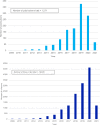Polygenic scores: prediction versus explanation
- PMID: 34686768
- PMCID: PMC8960389
- DOI: 10.1038/s41380-021-01348-y
Polygenic scores: prediction versus explanation
Abstract
During the past decade, polygenic scores have become a fast-growing area of research in the behavioural sciences. The ability to directly assess people's genetic propensities has transformed research by making it possible to add genetic predictors of traits to any study. The value of polygenic scores in the behavioural sciences rests on using inherited DNA differences to predict, from birth, common disorders and complex traits in unrelated individuals in the population. This predictive power of polygenic scores does not require knowing anything about the processes that lie between genes and behaviour. It also does not mandate disentangling the extent to which the prediction is due to assortative mating, genotype-environment correlation, or even population stratification. Although bottom-up explanation from genes to brain to behaviour will remain the long-term goal of the behavioural sciences, prediction is also a worthy achievement because it has immediate practical utility for identifying individuals at risk and is the necessary first step towards explanation. A high priority for research must be to increase the predictive power of polygenic scores to be able to use them as an early warning system to prevent problems.
© 2021. The Author(s).
Conflict of interest statement
The authors declare no competing interests.
Figures
References
-
- Wray NR, Lin T, Austin J, McGrath JJ, Hickie IB, Murray GK, et al. From basic science to clinical application of polygenic risk scores: a primer. JAMA Psychiatry. 2021;78:101. - PubMed
Publication types
MeSH terms
Grants and funding
LinkOut - more resources
Full Text Sources
Miscellaneous


